Analysing Organisational Behaviour: Culture, Power, and Team Dynamics
VerifiedAdded on 2023/06/05
|13
|4512
|457
Report
AI Summary
This report provides an in-depth analysis of organisational behaviour, focusing on how an organisation's culture, politics, and power dynamics influence individual and team behaviour and performance, using Tesco PLC as a case study. It evaluates content and process theories of motivation, motivational techniques, and the characteristics of effective versus ineffective teams. The report also applies philosophies and concepts of organisational behaviour within the context of Tesco, examining the impact of Handy's culture model, organisational power, and politics on employee motivation and productivity. It critically assesses the positive and negative impacts of these factors and provides recommendations for fostering a more motivated and productive work environment. Further, it discusses various motivation theories such as Maslow's hierarchy of needs, Herzberg's two-factor theory, Vroom's expectancy theory, and the equity theory, emphasizing the importance of employee satisfaction and fair treatment. The report concludes by highlighting the key elements of effective teams and the detrimental effects of negative competition and poor communication.
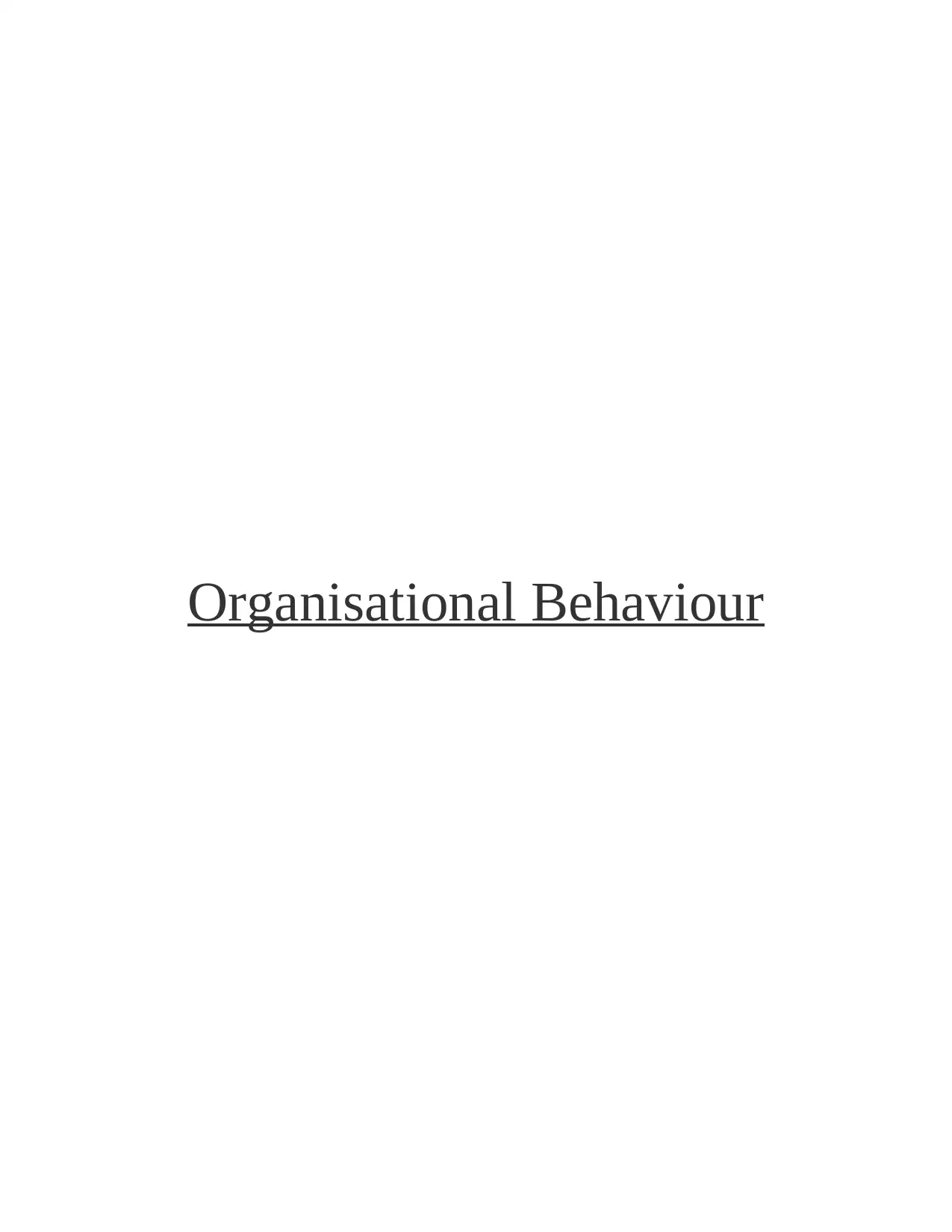
Organisational Behaviour
Paraphrase This Document
Need a fresh take? Get an instant paraphrase of this document with our AI Paraphraser
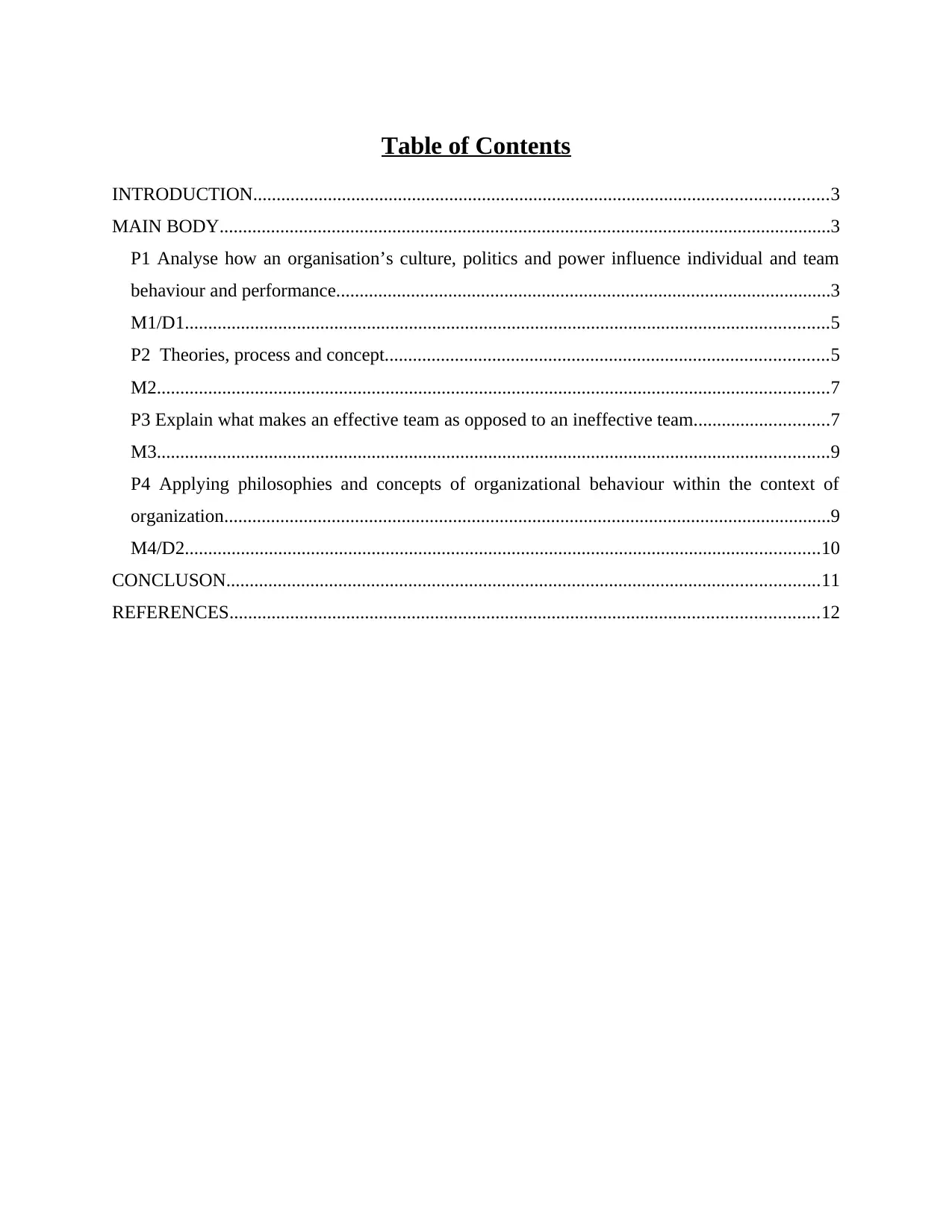
Table of Contents
INTRODUCTION...........................................................................................................................3
MAIN BODY...................................................................................................................................3
P1 Analyse how an organisation’s culture, politics and power influence individual and team
behaviour and performance..........................................................................................................3
M1/D1..........................................................................................................................................5
P2 Theories, process and concept...............................................................................................5
M2................................................................................................................................................7
P3 Explain what makes an effective team as opposed to an ineffective team.............................7
M3................................................................................................................................................9
P4 Applying philosophies and concepts of organizational behaviour within the context of
organization..................................................................................................................................9
M4/D2........................................................................................................................................10
CONCLUSON...............................................................................................................................11
REFERENCES..............................................................................................................................12
INTRODUCTION...........................................................................................................................3
MAIN BODY...................................................................................................................................3
P1 Analyse how an organisation’s culture, politics and power influence individual and team
behaviour and performance..........................................................................................................3
M1/D1..........................................................................................................................................5
P2 Theories, process and concept...............................................................................................5
M2................................................................................................................................................7
P3 Explain what makes an effective team as opposed to an ineffective team.............................7
M3................................................................................................................................................9
P4 Applying philosophies and concepts of organizational behaviour within the context of
organization..................................................................................................................................9
M4/D2........................................................................................................................................10
CONCLUSON...............................................................................................................................11
REFERENCES..............................................................................................................................12
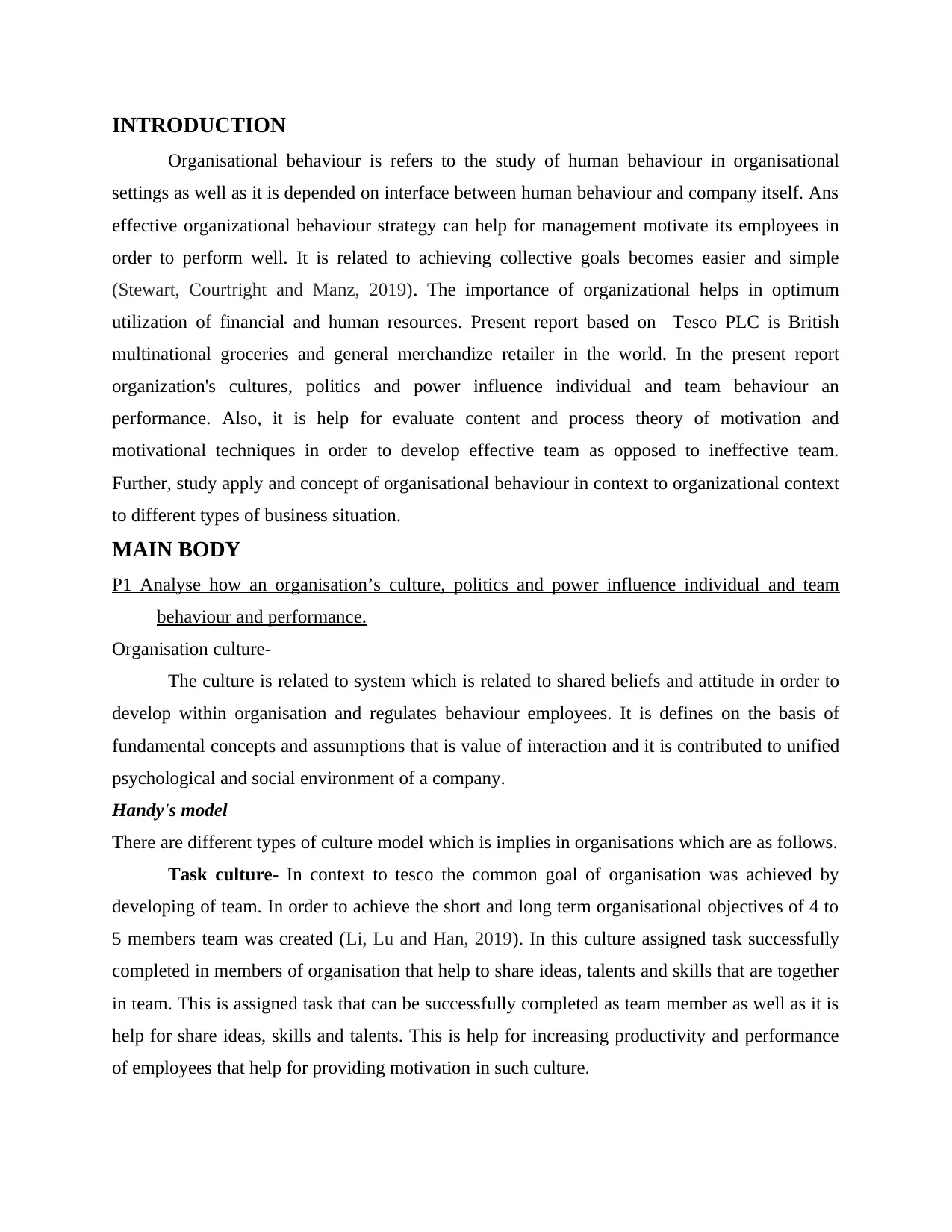
INTRODUCTION
Organisational behaviour is refers to the study of human behaviour in organisational
settings as well as it is depended on interface between human behaviour and company itself. Ans
effective organizational behaviour strategy can help for management motivate its employees in
order to perform well. It is related to achieving collective goals becomes easier and simple
(Stewart, Courtright and Manz, 2019). The importance of organizational helps in optimum
utilization of financial and human resources. Present report based on Tesco PLC is British
multinational groceries and general merchandize retailer in the world. In the present report
organization's cultures, politics and power influence individual and team behaviour an
performance. Also, it is help for evaluate content and process theory of motivation and
motivational techniques in order to develop effective team as opposed to ineffective team.
Further, study apply and concept of organisational behaviour in context to organizational context
to different types of business situation.
MAIN BODY
P1 Analyse how an organisation’s culture, politics and power influence individual and team
behaviour and performance.
Organisation culture-
The culture is related to system which is related to shared beliefs and attitude in order to
develop within organisation and regulates behaviour employees. It is defines on the basis of
fundamental concepts and assumptions that is value of interaction and it is contributed to unified
psychological and social environment of a company.
Handy's model
There are different types of culture model which is implies in organisations which are as follows.
Task culture- In context to tesco the common goal of organisation was achieved by
developing of team. In order to achieve the short and long term organisational objectives of 4 to
5 members team was created (Li, Lu and Han, 2019). In this culture assigned task successfully
completed in members of organisation that help to share ideas, talents and skills that are together
in team. This is assigned task that can be successfully completed as team member as well as it is
help for share ideas, skills and talents. This is help for increasing productivity and performance
of employees that help for providing motivation in such culture.
Organisational behaviour is refers to the study of human behaviour in organisational
settings as well as it is depended on interface between human behaviour and company itself. Ans
effective organizational behaviour strategy can help for management motivate its employees in
order to perform well. It is related to achieving collective goals becomes easier and simple
(Stewart, Courtright and Manz, 2019). The importance of organizational helps in optimum
utilization of financial and human resources. Present report based on Tesco PLC is British
multinational groceries and general merchandize retailer in the world. In the present report
organization's cultures, politics and power influence individual and team behaviour an
performance. Also, it is help for evaluate content and process theory of motivation and
motivational techniques in order to develop effective team as opposed to ineffective team.
Further, study apply and concept of organisational behaviour in context to organizational context
to different types of business situation.
MAIN BODY
P1 Analyse how an organisation’s culture, politics and power influence individual and team
behaviour and performance.
Organisation culture-
The culture is related to system which is related to shared beliefs and attitude in order to
develop within organisation and regulates behaviour employees. It is defines on the basis of
fundamental concepts and assumptions that is value of interaction and it is contributed to unified
psychological and social environment of a company.
Handy's model
There are different types of culture model which is implies in organisations which are as follows.
Task culture- In context to tesco the common goal of organisation was achieved by
developing of team. In order to achieve the short and long term organisational objectives of 4 to
5 members team was created (Li, Lu and Han, 2019). In this culture assigned task successfully
completed in members of organisation that help to share ideas, talents and skills that are together
in team. This is assigned task that can be successfully completed as team member as well as it is
help for share ideas, skills and talents. This is help for increasing productivity and performance
of employees that help for providing motivation in such culture.
⊘ This is a preview!⊘
Do you want full access?
Subscribe today to unlock all pages.

Trusted by 1+ million students worldwide
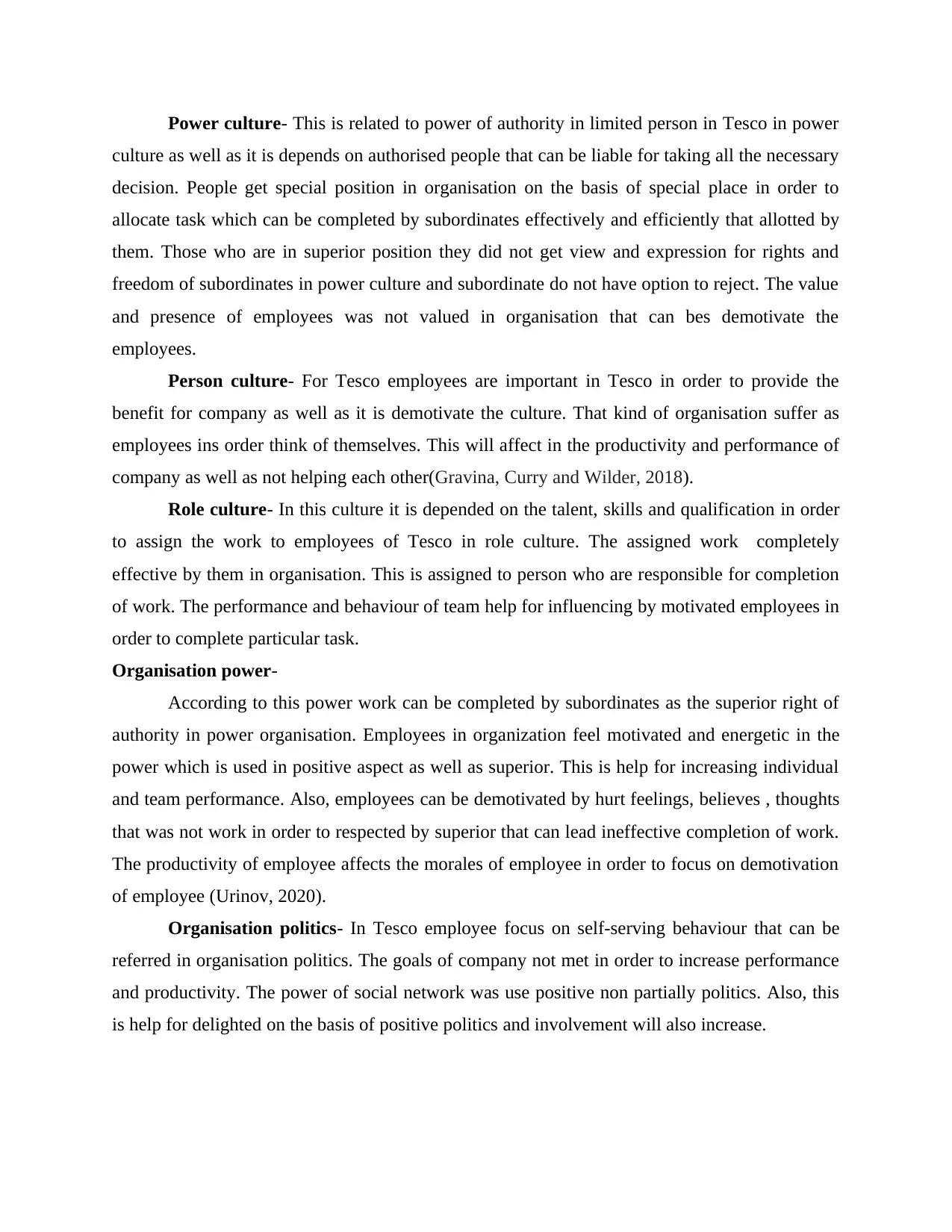
Power culture- This is related to power of authority in limited person in Tesco in power
culture as well as it is depends on authorised people that can be liable for taking all the necessary
decision. People get special position in organisation on the basis of special place in order to
allocate task which can be completed by subordinates effectively and efficiently that allotted by
them. Those who are in superior position they did not get view and expression for rights and
freedom of subordinates in power culture and subordinate do not have option to reject. The value
and presence of employees was not valued in organisation that can bes demotivate the
employees.
Person culture- For Tesco employees are important in Tesco in order to provide the
benefit for company as well as it is demotivate the culture. That kind of organisation suffer as
employees ins order think of themselves. This will affect in the productivity and performance of
company as well as not helping each other(Gravina, Curry and Wilder, 2018).
Role culture- In this culture it is depended on the talent, skills and qualification in order
to assign the work to employees of Tesco in role culture. The assigned work completely
effective by them in organisation. This is assigned to person who are responsible for completion
of work. The performance and behaviour of team help for influencing by motivated employees in
order to complete particular task.
Organisation power-
According to this power work can be completed by subordinates as the superior right of
authority in power organisation. Employees in organization feel motivated and energetic in the
power which is used in positive aspect as well as superior. This is help for increasing individual
and team performance. Also, employees can be demotivated by hurt feelings, believes , thoughts
that was not work in order to respected by superior that can lead ineffective completion of work.
The productivity of employee affects the morales of employee in order to focus on demotivation
of employee (Urinov, 2020).
Organisation politics- In Tesco employee focus on self-serving behaviour that can be
referred in organisation politics. The goals of company not met in order to increase performance
and productivity. The power of social network was use positive non partially politics. Also, this
is help for delighted on the basis of positive politics and involvement will also increase.
culture as well as it is depends on authorised people that can be liable for taking all the necessary
decision. People get special position in organisation on the basis of special place in order to
allocate task which can be completed by subordinates effectively and efficiently that allotted by
them. Those who are in superior position they did not get view and expression for rights and
freedom of subordinates in power culture and subordinate do not have option to reject. The value
and presence of employees was not valued in organisation that can bes demotivate the
employees.
Person culture- For Tesco employees are important in Tesco in order to provide the
benefit for company as well as it is demotivate the culture. That kind of organisation suffer as
employees ins order think of themselves. This will affect in the productivity and performance of
company as well as not helping each other(Gravina, Curry and Wilder, 2018).
Role culture- In this culture it is depended on the talent, skills and qualification in order
to assign the work to employees of Tesco in role culture. The assigned work completely
effective by them in organisation. This is assigned to person who are responsible for completion
of work. The performance and behaviour of team help for influencing by motivated employees in
order to complete particular task.
Organisation power-
According to this power work can be completed by subordinates as the superior right of
authority in power organisation. Employees in organization feel motivated and energetic in the
power which is used in positive aspect as well as superior. This is help for increasing individual
and team performance. Also, employees can be demotivated by hurt feelings, believes , thoughts
that was not work in order to respected by superior that can lead ineffective completion of work.
The productivity of employee affects the morales of employee in order to focus on demotivation
of employee (Urinov, 2020).
Organisation politics- In Tesco employee focus on self-serving behaviour that can be
referred in organisation politics. The goals of company not met in order to increase performance
and productivity. The power of social network was use positive non partially politics. Also, this
is help for delighted on the basis of positive politics and involvement will also increase.
Paraphrase This Document
Need a fresh take? Get an instant paraphrase of this document with our AI Paraphraser
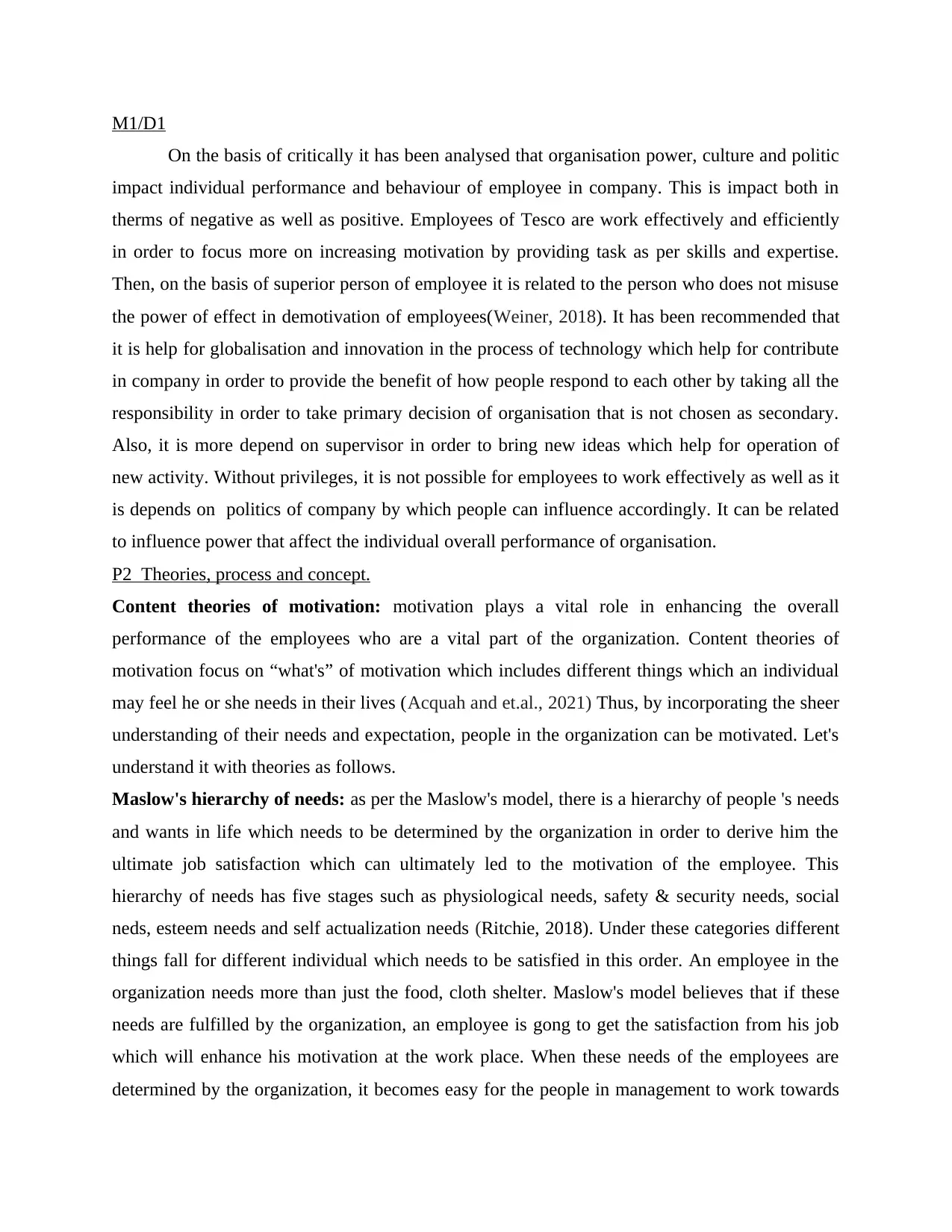
M1/D1
On the basis of critically it has been analysed that organisation power, culture and politic
impact individual performance and behaviour of employee in company. This is impact both in
therms of negative as well as positive. Employees of Tesco are work effectively and efficiently
in order to focus more on increasing motivation by providing task as per skills and expertise.
Then, on the basis of superior person of employee it is related to the person who does not misuse
the power of effect in demotivation of employees(Weiner, 2018). It has been recommended that
it is help for globalisation and innovation in the process of technology which help for contribute
in company in order to provide the benefit of how people respond to each other by taking all the
responsibility in order to take primary decision of organisation that is not chosen as secondary.
Also, it is more depend on supervisor in order to bring new ideas which help for operation of
new activity. Without privileges, it is not possible for employees to work effectively as well as it
is depends on politics of company by which people can influence accordingly. It can be related
to influence power that affect the individual overall performance of organisation.
P2 Theories, process and concept.
Content theories of motivation: motivation plays a vital role in enhancing the overall
performance of the employees who are a vital part of the organization. Content theories of
motivation focus on “what's” of motivation which includes different things which an individual
may feel he or she needs in their lives (Acquah and et.al., 2021) Thus, by incorporating the sheer
understanding of their needs and expectation, people in the organization can be motivated. Let's
understand it with theories as follows.
Maslow's hierarchy of needs: as per the Maslow's model, there is a hierarchy of people 's needs
and wants in life which needs to be determined by the organization in order to derive him the
ultimate job satisfaction which can ultimately led to the motivation of the employee. This
hierarchy of needs has five stages such as physiological needs, safety & security needs, social
neds, esteem needs and self actualization needs (Ritchie, 2018). Under these categories different
things fall for different individual which needs to be satisfied in this order. An employee in the
organization needs more than just the food, cloth shelter. Maslow's model believes that if these
needs are fulfilled by the organization, an employee is gong to get the satisfaction from his job
which will enhance his motivation at the work place. When these needs of the employees are
determined by the organization, it becomes easy for the people in management to work towards
On the basis of critically it has been analysed that organisation power, culture and politic
impact individual performance and behaviour of employee in company. This is impact both in
therms of negative as well as positive. Employees of Tesco are work effectively and efficiently
in order to focus more on increasing motivation by providing task as per skills and expertise.
Then, on the basis of superior person of employee it is related to the person who does not misuse
the power of effect in demotivation of employees(Weiner, 2018). It has been recommended that
it is help for globalisation and innovation in the process of technology which help for contribute
in company in order to provide the benefit of how people respond to each other by taking all the
responsibility in order to take primary decision of organisation that is not chosen as secondary.
Also, it is more depend on supervisor in order to bring new ideas which help for operation of
new activity. Without privileges, it is not possible for employees to work effectively as well as it
is depends on politics of company by which people can influence accordingly. It can be related
to influence power that affect the individual overall performance of organisation.
P2 Theories, process and concept.
Content theories of motivation: motivation plays a vital role in enhancing the overall
performance of the employees who are a vital part of the organization. Content theories of
motivation focus on “what's” of motivation which includes different things which an individual
may feel he or she needs in their lives (Acquah and et.al., 2021) Thus, by incorporating the sheer
understanding of their needs and expectation, people in the organization can be motivated. Let's
understand it with theories as follows.
Maslow's hierarchy of needs: as per the Maslow's model, there is a hierarchy of people 's needs
and wants in life which needs to be determined by the organization in order to derive him the
ultimate job satisfaction which can ultimately led to the motivation of the employee. This
hierarchy of needs has five stages such as physiological needs, safety & security needs, social
neds, esteem needs and self actualization needs (Ritchie, 2018). Under these categories different
things fall for different individual which needs to be satisfied in this order. An employee in the
organization needs more than just the food, cloth shelter. Maslow's model believes that if these
needs are fulfilled by the organization, an employee is gong to get the satisfaction from his job
which will enhance his motivation at the work place. When these needs of the employees are
determined by the organization, it becomes easy for the people in management to work towards
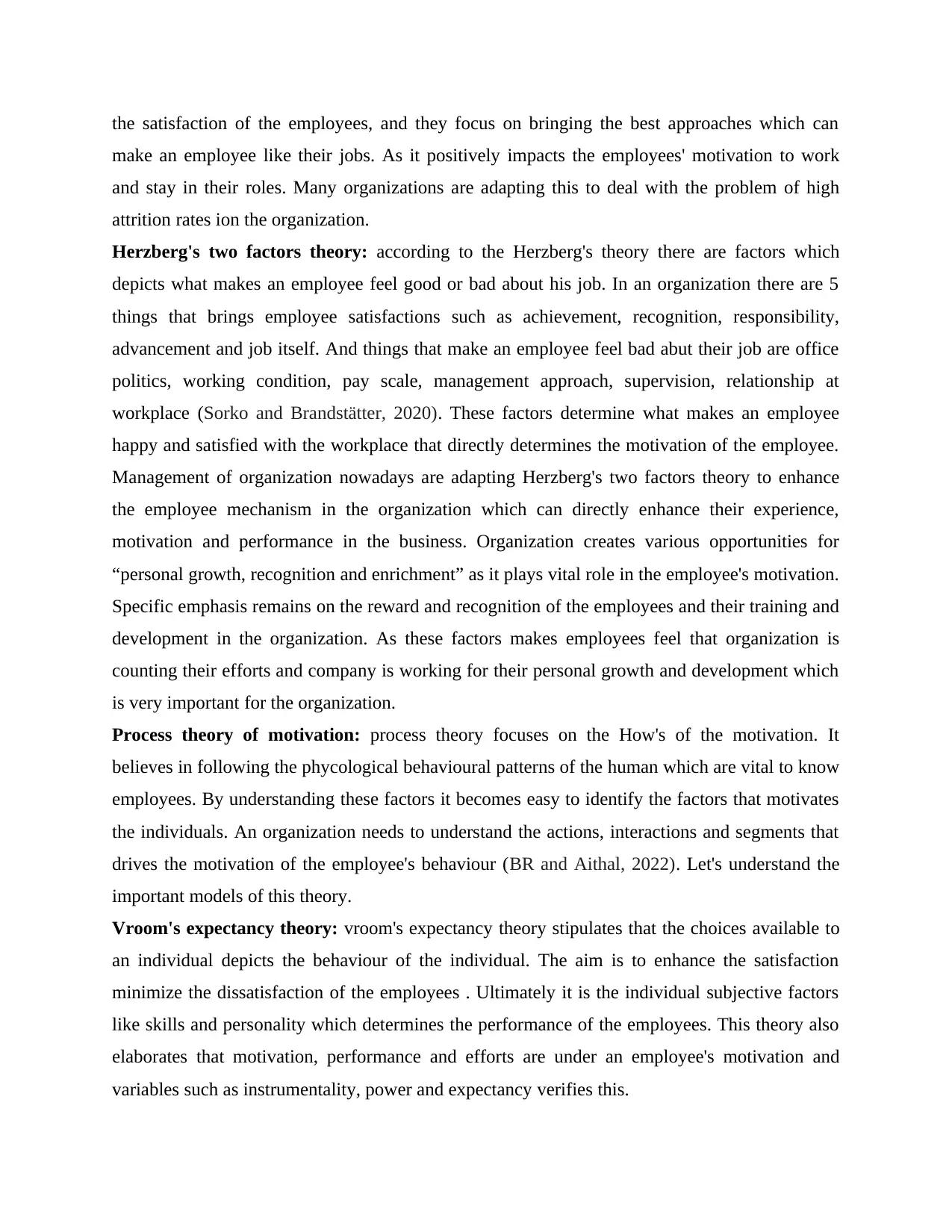
the satisfaction of the employees, and they focus on bringing the best approaches which can
make an employee like their jobs. As it positively impacts the employees' motivation to work
and stay in their roles. Many organizations are adapting this to deal with the problem of high
attrition rates ion the organization.
Herzberg's two factors theory: according to the Herzberg's theory there are factors which
depicts what makes an employee feel good or bad about his job. In an organization there are 5
things that brings employee satisfactions such as achievement, recognition, responsibility,
advancement and job itself. And things that make an employee feel bad abut their job are office
politics, working condition, pay scale, management approach, supervision, relationship at
workplace (Sorko and Brandstätter, 2020). These factors determine what makes an employee
happy and satisfied with the workplace that directly determines the motivation of the employee.
Management of organization nowadays are adapting Herzberg's two factors theory to enhance
the employee mechanism in the organization which can directly enhance their experience,
motivation and performance in the business. Organization creates various opportunities for
“personal growth, recognition and enrichment” as it plays vital role in the employee's motivation.
Specific emphasis remains on the reward and recognition of the employees and their training and
development in the organization. As these factors makes employees feel that organization is
counting their efforts and company is working for their personal growth and development which
is very important for the organization.
Process theory of motivation: process theory focuses on the How's of the motivation. It
believes in following the phycological behavioural patterns of the human which are vital to know
employees. By understanding these factors it becomes easy to identify the factors that motivates
the individuals. An organization needs to understand the actions, interactions and segments that
drives the motivation of the employee's behaviour (BR and Aithal, 2022). Let's understand the
important models of this theory.
Vroom's expectancy theory: vroom's expectancy theory stipulates that the choices available to
an individual depicts the behaviour of the individual. The aim is to enhance the satisfaction
minimize the dissatisfaction of the employees . Ultimately it is the individual subjective factors
like skills and personality which determines the performance of the employees. This theory also
elaborates that motivation, performance and efforts are under an employee's motivation and
variables such as instrumentality, power and expectancy verifies this.
make an employee like their jobs. As it positively impacts the employees' motivation to work
and stay in their roles. Many organizations are adapting this to deal with the problem of high
attrition rates ion the organization.
Herzberg's two factors theory: according to the Herzberg's theory there are factors which
depicts what makes an employee feel good or bad about his job. In an organization there are 5
things that brings employee satisfactions such as achievement, recognition, responsibility,
advancement and job itself. And things that make an employee feel bad abut their job are office
politics, working condition, pay scale, management approach, supervision, relationship at
workplace (Sorko and Brandstätter, 2020). These factors determine what makes an employee
happy and satisfied with the workplace that directly determines the motivation of the employee.
Management of organization nowadays are adapting Herzberg's two factors theory to enhance
the employee mechanism in the organization which can directly enhance their experience,
motivation and performance in the business. Organization creates various opportunities for
“personal growth, recognition and enrichment” as it plays vital role in the employee's motivation.
Specific emphasis remains on the reward and recognition of the employees and their training and
development in the organization. As these factors makes employees feel that organization is
counting their efforts and company is working for their personal growth and development which
is very important for the organization.
Process theory of motivation: process theory focuses on the How's of the motivation. It
believes in following the phycological behavioural patterns of the human which are vital to know
employees. By understanding these factors it becomes easy to identify the factors that motivates
the individuals. An organization needs to understand the actions, interactions and segments that
drives the motivation of the employee's behaviour (BR and Aithal, 2022). Let's understand the
important models of this theory.
Vroom's expectancy theory: vroom's expectancy theory stipulates that the choices available to
an individual depicts the behaviour of the individual. The aim is to enhance the satisfaction
minimize the dissatisfaction of the employees . Ultimately it is the individual subjective factors
like skills and personality which determines the performance of the employees. This theory also
elaborates that motivation, performance and efforts are under an employee's motivation and
variables such as instrumentality, power and expectancy verifies this.
⊘ This is a preview!⊘
Do you want full access?
Subscribe today to unlock all pages.

Trusted by 1+ million students worldwide
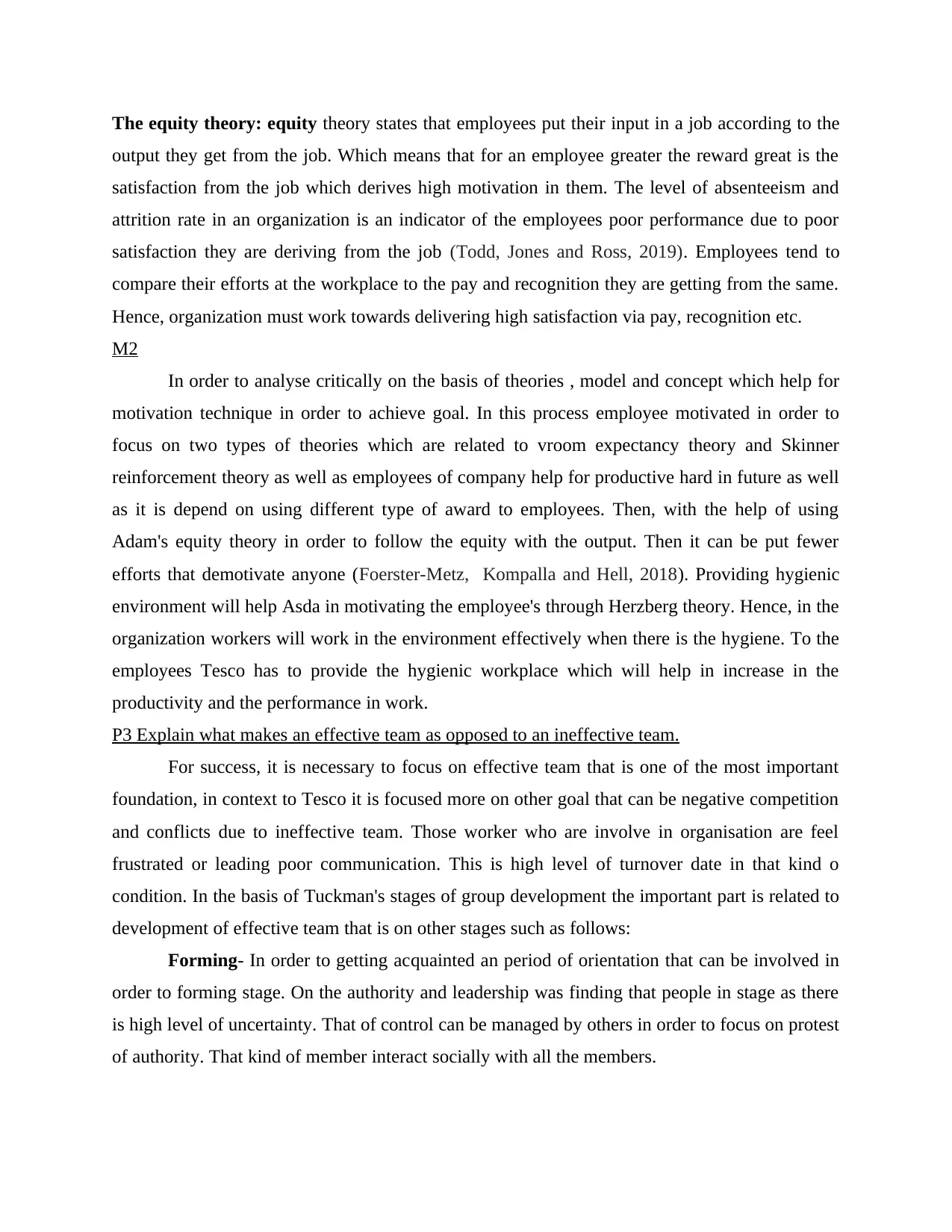
The equity theory: equity theory states that employees put their input in a job according to the
output they get from the job. Which means that for an employee greater the reward great is the
satisfaction from the job which derives high motivation in them. The level of absenteeism and
attrition rate in an organization is an indicator of the employees poor performance due to poor
satisfaction they are deriving from the job (Todd, Jones and Ross, 2019). Employees tend to
compare their efforts at the workplace to the pay and recognition they are getting from the same.
Hence, organization must work towards delivering high satisfaction via pay, recognition etc.
M2
In order to analyse critically on the basis of theories , model and concept which help for
motivation technique in order to achieve goal. In this process employee motivated in order to
focus on two types of theories which are related to vroom expectancy theory and Skinner
reinforcement theory as well as employees of company help for productive hard in future as well
as it is depend on using different type of award to employees. Then, with the help of using
Adam's equity theory in order to follow the equity with the output. Then it can be put fewer
efforts that demotivate anyone (Foerster-Metz, Kompalla and Hell, 2018). Providing hygienic
environment will help Asda in motivating the employee's through Herzberg theory. Hence, in the
organization workers will work in the environment effectively when there is the hygiene. To the
employees Tesco has to provide the hygienic workplace which will help in increase in the
productivity and the performance in work.
P3 Explain what makes an effective team as opposed to an ineffective team.
For success, it is necessary to focus on effective team that is one of the most important
foundation, in context to Tesco it is focused more on other goal that can be negative competition
and conflicts due to ineffective team. Those worker who are involve in organisation are feel
frustrated or leading poor communication. This is high level of turnover date in that kind o
condition. In the basis of Tuckman's stages of group development the important part is related to
development of effective team that is on other stages such as follows:
Forming- In order to getting acquainted an period of orientation that can be involved in
order to forming stage. On the authority and leadership was finding that people in stage as there
is high level of uncertainty. That of control can be managed by others in order to focus on protest
of authority. That kind of member interact socially with all the members.
output they get from the job. Which means that for an employee greater the reward great is the
satisfaction from the job which derives high motivation in them. The level of absenteeism and
attrition rate in an organization is an indicator of the employees poor performance due to poor
satisfaction they are deriving from the job (Todd, Jones and Ross, 2019). Employees tend to
compare their efforts at the workplace to the pay and recognition they are getting from the same.
Hence, organization must work towards delivering high satisfaction via pay, recognition etc.
M2
In order to analyse critically on the basis of theories , model and concept which help for
motivation technique in order to achieve goal. In this process employee motivated in order to
focus on two types of theories which are related to vroom expectancy theory and Skinner
reinforcement theory as well as employees of company help for productive hard in future as well
as it is depend on using different type of award to employees. Then, with the help of using
Adam's equity theory in order to follow the equity with the output. Then it can be put fewer
efforts that demotivate anyone (Foerster-Metz, Kompalla and Hell, 2018). Providing hygienic
environment will help Asda in motivating the employee's through Herzberg theory. Hence, in the
organization workers will work in the environment effectively when there is the hygiene. To the
employees Tesco has to provide the hygienic workplace which will help in increase in the
productivity and the performance in work.
P3 Explain what makes an effective team as opposed to an ineffective team.
For success, it is necessary to focus on effective team that is one of the most important
foundation, in context to Tesco it is focused more on other goal that can be negative competition
and conflicts due to ineffective team. Those worker who are involve in organisation are feel
frustrated or leading poor communication. This is high level of turnover date in that kind o
condition. In the basis of Tuckman's stages of group development the important part is related to
development of effective team that is on other stages such as follows:
Forming- In order to getting acquainted an period of orientation that can be involved in
order to forming stage. On the authority and leadership was finding that people in stage as there
is high level of uncertainty. That of control can be managed by others in order to focus on protest
of authority. That kind of member interact socially with all the members.
Paraphrase This Document
Need a fresh take? Get an instant paraphrase of this document with our AI Paraphraser
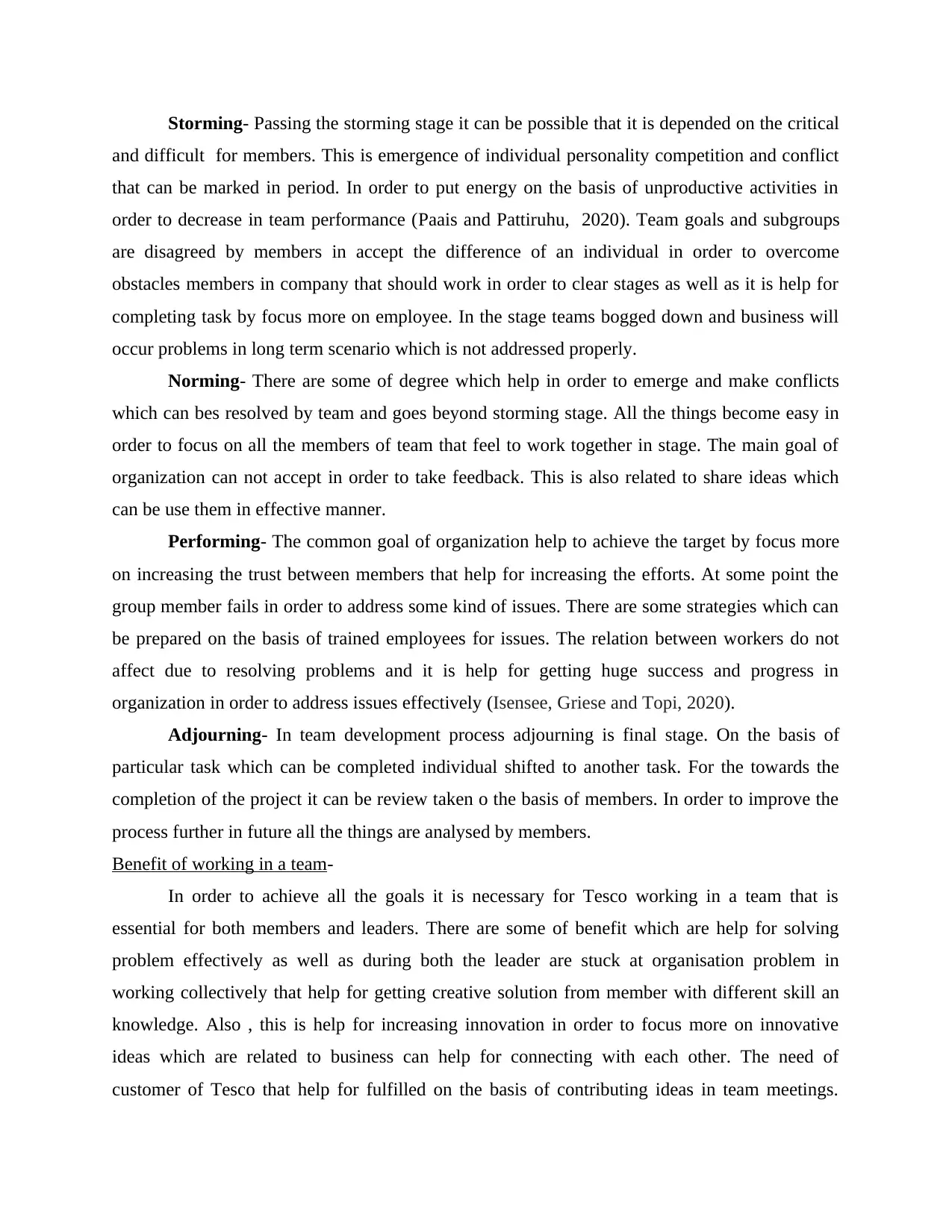
Storming- Passing the storming stage it can be possible that it is depended on the critical
and difficult for members. This is emergence of individual personality competition and conflict
that can be marked in period. In order to put energy on the basis of unproductive activities in
order to decrease in team performance (Paais and Pattiruhu, 2020). Team goals and subgroups
are disagreed by members in accept the difference of an individual in order to overcome
obstacles members in company that should work in order to clear stages as well as it is help for
completing task by focus more on employee. In the stage teams bogged down and business will
occur problems in long term scenario which is not addressed properly.
Norming- There are some of degree which help in order to emerge and make conflicts
which can bes resolved by team and goes beyond storming stage. All the things become easy in
order to focus on all the members of team that feel to work together in stage. The main goal of
organization can not accept in order to take feedback. This is also related to share ideas which
can be use them in effective manner.
Performing- The common goal of organization help to achieve the target by focus more
on increasing the trust between members that help for increasing the efforts. At some point the
group member fails in order to address some kind of issues. There are some strategies which can
be prepared on the basis of trained employees for issues. The relation between workers do not
affect due to resolving problems and it is help for getting huge success and progress in
organization in order to address issues effectively (Isensee, Griese and Topi, 2020).
Adjourning- In team development process adjourning is final stage. On the basis of
particular task which can be completed individual shifted to another task. For the towards the
completion of the project it can be review taken o the basis of members. In order to improve the
process further in future all the things are analysed by members.
Benefit of working in a team-
In order to achieve all the goals it is necessary for Tesco working in a team that is
essential for both members and leaders. There are some of benefit which are help for solving
problem effectively as well as during both the leader are stuck at organisation problem in
working collectively that help for getting creative solution from member with different skill an
knowledge. Also , this is help for increasing innovation in order to focus more on innovative
ideas which are related to business can help for connecting with each other. The need of
customer of Tesco that help for fulfilled on the basis of contributing ideas in team meetings.
and difficult for members. This is emergence of individual personality competition and conflict
that can be marked in period. In order to put energy on the basis of unproductive activities in
order to decrease in team performance (Paais and Pattiruhu, 2020). Team goals and subgroups
are disagreed by members in accept the difference of an individual in order to overcome
obstacles members in company that should work in order to clear stages as well as it is help for
completing task by focus more on employee. In the stage teams bogged down and business will
occur problems in long term scenario which is not addressed properly.
Norming- There are some of degree which help in order to emerge and make conflicts
which can bes resolved by team and goes beyond storming stage. All the things become easy in
order to focus on all the members of team that feel to work together in stage. The main goal of
organization can not accept in order to take feedback. This is also related to share ideas which
can be use them in effective manner.
Performing- The common goal of organization help to achieve the target by focus more
on increasing the trust between members that help for increasing the efforts. At some point the
group member fails in order to address some kind of issues. There are some strategies which can
be prepared on the basis of trained employees for issues. The relation between workers do not
affect due to resolving problems and it is help for getting huge success and progress in
organization in order to address issues effectively (Isensee, Griese and Topi, 2020).
Adjourning- In team development process adjourning is final stage. On the basis of
particular task which can be completed individual shifted to another task. For the towards the
completion of the project it can be review taken o the basis of members. In order to improve the
process further in future all the things are analysed by members.
Benefit of working in a team-
In order to achieve all the goals it is necessary for Tesco working in a team that is
essential for both members and leaders. There are some of benefit which are help for solving
problem effectively as well as during both the leader are stuck at organisation problem in
working collectively that help for getting creative solution from member with different skill an
knowledge. Also , this is help for increasing innovation in order to focus more on innovative
ideas which are related to business can help for connecting with each other. The need of
customer of Tesco that help for fulfilled on the basis of contributing ideas in team meetings.
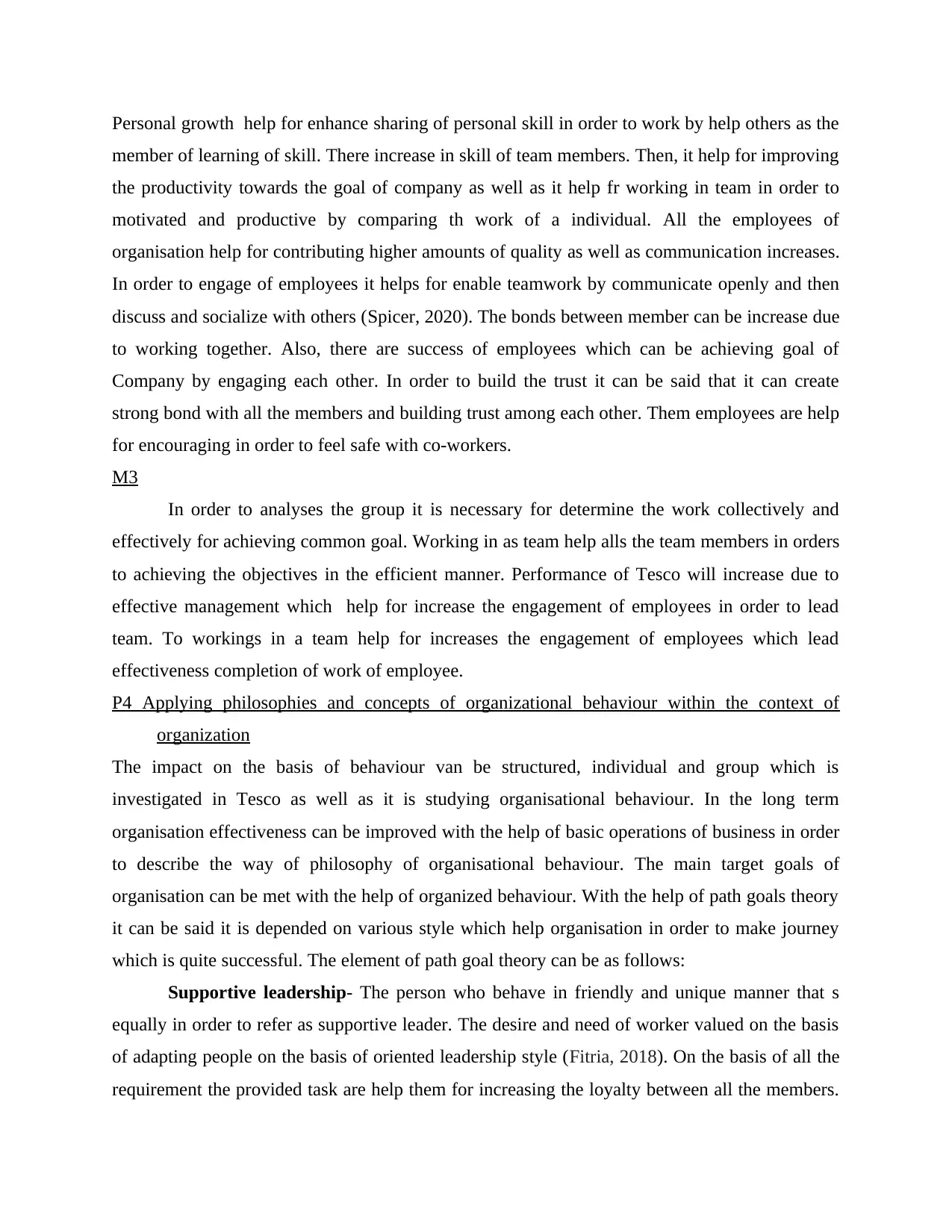
Personal growth help for enhance sharing of personal skill in order to work by help others as the
member of learning of skill. There increase in skill of team members. Then, it help for improving
the productivity towards the goal of company as well as it help fr working in team in order to
motivated and productive by comparing th work of a individual. All the employees of
organisation help for contributing higher amounts of quality as well as communication increases.
In order to engage of employees it helps for enable teamwork by communicate openly and then
discuss and socialize with others (Spicer, 2020). The bonds between member can be increase due
to working together. Also, there are success of employees which can be achieving goal of
Company by engaging each other. In order to build the trust it can be said that it can create
strong bond with all the members and building trust among each other. Them employees are help
for encouraging in order to feel safe with co-workers.
M3
In order to analyses the group it is necessary for determine the work collectively and
effectively for achieving common goal. Working in as team help alls the team members in orders
to achieving the objectives in the efficient manner. Performance of Tesco will increase due to
effective management which help for increase the engagement of employees in order to lead
team. To workings in a team help for increases the engagement of employees which lead
effectiveness completion of work of employee.
P4 Applying philosophies and concepts of organizational behaviour within the context of
organization
The impact on the basis of behaviour van be structured, individual and group which is
investigated in Tesco as well as it is studying organisational behaviour. In the long term
organisation effectiveness can be improved with the help of basic operations of business in order
to describe the way of philosophy of organisational behaviour. The main target goals of
organisation can be met with the help of organized behaviour. With the help of path goals theory
it can be said it is depended on various style which help organisation in order to make journey
which is quite successful. The element of path goal theory can be as follows:
Supportive leadership- The person who behave in friendly and unique manner that s
equally in order to refer as supportive leader. The desire and need of worker valued on the basis
of adapting people on the basis of oriented leadership style (Fitria, 2018). On the basis of all the
requirement the provided task are help them for increasing the loyalty between all the members.
member of learning of skill. There increase in skill of team members. Then, it help for improving
the productivity towards the goal of company as well as it help fr working in team in order to
motivated and productive by comparing th work of a individual. All the employees of
organisation help for contributing higher amounts of quality as well as communication increases.
In order to engage of employees it helps for enable teamwork by communicate openly and then
discuss and socialize with others (Spicer, 2020). The bonds between member can be increase due
to working together. Also, there are success of employees which can be achieving goal of
Company by engaging each other. In order to build the trust it can be said that it can create
strong bond with all the members and building trust among each other. Them employees are help
for encouraging in order to feel safe with co-workers.
M3
In order to analyses the group it is necessary for determine the work collectively and
effectively for achieving common goal. Working in as team help alls the team members in orders
to achieving the objectives in the efficient manner. Performance of Tesco will increase due to
effective management which help for increase the engagement of employees in order to lead
team. To workings in a team help for increases the engagement of employees which lead
effectiveness completion of work of employee.
P4 Applying philosophies and concepts of organizational behaviour within the context of
organization
The impact on the basis of behaviour van be structured, individual and group which is
investigated in Tesco as well as it is studying organisational behaviour. In the long term
organisation effectiveness can be improved with the help of basic operations of business in order
to describe the way of philosophy of organisational behaviour. The main target goals of
organisation can be met with the help of organized behaviour. With the help of path goals theory
it can be said it is depended on various style which help organisation in order to make journey
which is quite successful. The element of path goal theory can be as follows:
Supportive leadership- The person who behave in friendly and unique manner that s
equally in order to refer as supportive leader. The desire and need of worker valued on the basis
of adapting people on the basis of oriented leadership style (Fitria, 2018). On the basis of all the
requirement the provided task are help them for increasing the loyalty between all the members.
⊘ This is a preview!⊘
Do you want full access?
Subscribe today to unlock all pages.

Trusted by 1+ million students worldwide
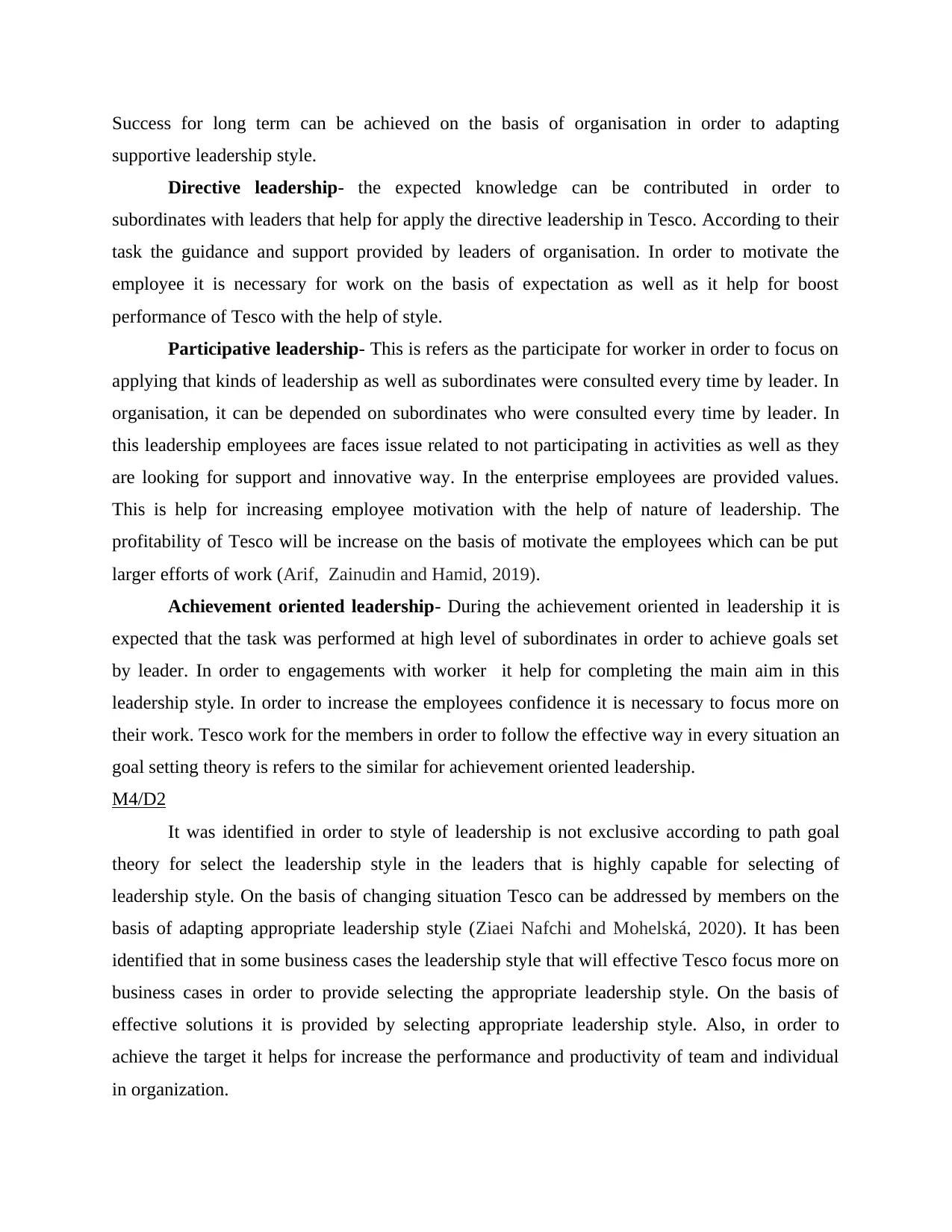
Success for long term can be achieved on the basis of organisation in order to adapting
supportive leadership style.
Directive leadership- the expected knowledge can be contributed in order to
subordinates with leaders that help for apply the directive leadership in Tesco. According to their
task the guidance and support provided by leaders of organisation. In order to motivate the
employee it is necessary for work on the basis of expectation as well as it help for boost
performance of Tesco with the help of style.
Participative leadership- This is refers as the participate for worker in order to focus on
applying that kinds of leadership as well as subordinates were consulted every time by leader. In
organisation, it can be depended on subordinates who were consulted every time by leader. In
this leadership employees are faces issue related to not participating in activities as well as they
are looking for support and innovative way. In the enterprise employees are provided values.
This is help for increasing employee motivation with the help of nature of leadership. The
profitability of Tesco will be increase on the basis of motivate the employees which can be put
larger efforts of work (Arif, Zainudin and Hamid, 2019).
Achievement oriented leadership- During the achievement oriented in leadership it is
expected that the task was performed at high level of subordinates in order to achieve goals set
by leader. In order to engagements with worker it help for completing the main aim in this
leadership style. In order to increase the employees confidence it is necessary to focus more on
their work. Tesco work for the members in order to follow the effective way in every situation an
goal setting theory is refers to the similar for achievement oriented leadership.
M4/D2
It was identified in order to style of leadership is not exclusive according to path goal
theory for select the leadership style in the leaders that is highly capable for selecting of
leadership style. On the basis of changing situation Tesco can be addressed by members on the
basis of adapting appropriate leadership style (Ziaei Nafchi and Mohelská, 2020). It has been
identified that in some business cases the leadership style that will effective Tesco focus more on
business cases in order to provide selecting the appropriate leadership style. On the basis of
effective solutions it is provided by selecting appropriate leadership style. Also, in order to
achieve the target it helps for increase the performance and productivity of team and individual
in organization.
supportive leadership style.
Directive leadership- the expected knowledge can be contributed in order to
subordinates with leaders that help for apply the directive leadership in Tesco. According to their
task the guidance and support provided by leaders of organisation. In order to motivate the
employee it is necessary for work on the basis of expectation as well as it help for boost
performance of Tesco with the help of style.
Participative leadership- This is refers as the participate for worker in order to focus on
applying that kinds of leadership as well as subordinates were consulted every time by leader. In
organisation, it can be depended on subordinates who were consulted every time by leader. In
this leadership employees are faces issue related to not participating in activities as well as they
are looking for support and innovative way. In the enterprise employees are provided values.
This is help for increasing employee motivation with the help of nature of leadership. The
profitability of Tesco will be increase on the basis of motivate the employees which can be put
larger efforts of work (Arif, Zainudin and Hamid, 2019).
Achievement oriented leadership- During the achievement oriented in leadership it is
expected that the task was performed at high level of subordinates in order to achieve goals set
by leader. In order to engagements with worker it help for completing the main aim in this
leadership style. In order to increase the employees confidence it is necessary to focus more on
their work. Tesco work for the members in order to follow the effective way in every situation an
goal setting theory is refers to the similar for achievement oriented leadership.
M4/D2
It was identified in order to style of leadership is not exclusive according to path goal
theory for select the leadership style in the leaders that is highly capable for selecting of
leadership style. On the basis of changing situation Tesco can be addressed by members on the
basis of adapting appropriate leadership style (Ziaei Nafchi and Mohelská, 2020). It has been
identified that in some business cases the leadership style that will effective Tesco focus more on
business cases in order to provide selecting the appropriate leadership style. On the basis of
effective solutions it is provided by selecting appropriate leadership style. Also, in order to
achieve the target it helps for increase the performance and productivity of team and individual
in organization.
Paraphrase This Document
Need a fresh take? Get an instant paraphrase of this document with our AI Paraphraser
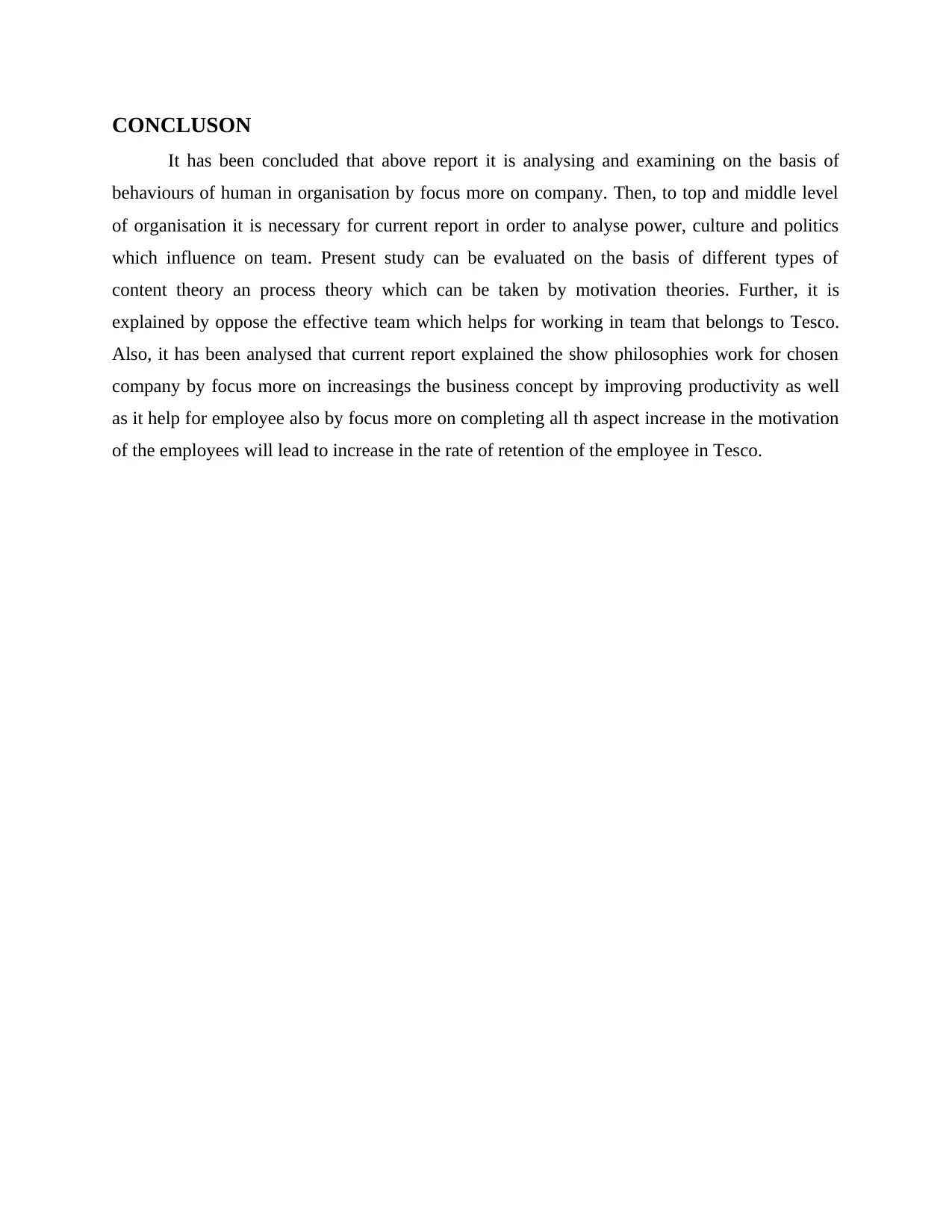
CONCLUSON
It has been concluded that above report it is analysing and examining on the basis of
behaviours of human in organisation by focus more on company. Then, to top and middle level
of organisation it is necessary for current report in order to analyse power, culture and politics
which influence on team. Present study can be evaluated on the basis of different types of
content theory an process theory which can be taken by motivation theories. Further, it is
explained by oppose the effective team which helps for working in team that belongs to Tesco.
Also, it has been analysed that current report explained the show philosophies work for chosen
company by focus more on increasings the business concept by improving productivity as well
as it help for employee also by focus more on completing all th aspect increase in the motivation
of the employees will lead to increase in the rate of retention of the employee in Tesco.
It has been concluded that above report it is analysing and examining on the basis of
behaviours of human in organisation by focus more on company. Then, to top and middle level
of organisation it is necessary for current report in order to analyse power, culture and politics
which influence on team. Present study can be evaluated on the basis of different types of
content theory an process theory which can be taken by motivation theories. Further, it is
explained by oppose the effective team which helps for working in team that belongs to Tesco.
Also, it has been analysed that current report explained the show philosophies work for chosen
company by focus more on increasings the business concept by improving productivity as well
as it help for employee also by focus more on completing all th aspect increase in the motivation
of the employees will lead to increase in the rate of retention of the employee in Tesco.
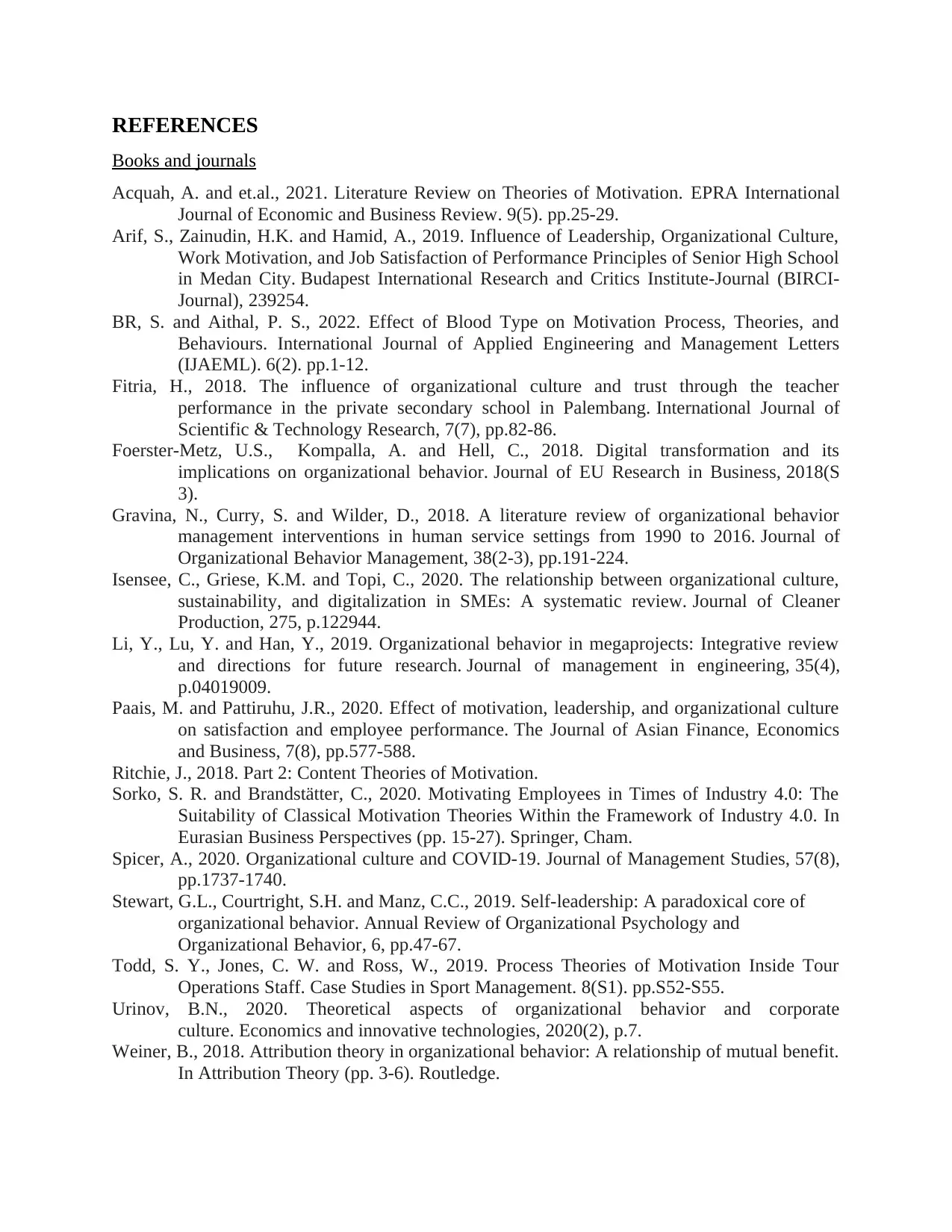
REFERENCES
Books and journals
Acquah, A. and et.al., 2021. Literature Review on Theories of Motivation. EPRA International
Journal of Economic and Business Review. 9(5). pp.25-29.
Arif, S., Zainudin, H.K. and Hamid, A., 2019. Influence of Leadership, Organizational Culture,
Work Motivation, and Job Satisfaction of Performance Principles of Senior High School
in Medan City. Budapest International Research and Critics Institute-Journal (BIRCI-
Journal), 239254.
BR, S. and Aithal, P. S., 2022. Effect of Blood Type on Motivation Process, Theories, and
Behaviours. International Journal of Applied Engineering and Management Letters
(IJAEML). 6(2). pp.1-12.
Fitria, H., 2018. The influence of organizational culture and trust through the teacher
performance in the private secondary school in Palembang. International Journal of
Scientific & Technology Research, 7(7), pp.82-86.
Foerster-Metz, U.S., Kompalla, A. and Hell, C., 2018. Digital transformation and its
implications on organizational behavior. Journal of EU Research in Business, 2018(S
3).
Gravina, N., Curry, S. and Wilder, D., 2018. A literature review of organizational behavior
management interventions in human service settings from 1990 to 2016. Journal of
Organizational Behavior Management, 38(2-3), pp.191-224.
Isensee, C., Griese, K.M. and Topi, C., 2020. The relationship between organizational culture,
sustainability, and digitalization in SMEs: A systematic review. Journal of Cleaner
Production, 275, p.122944.
Li, Y., Lu, Y. and Han, Y., 2019. Organizational behavior in megaprojects: Integrative review
and directions for future research. Journal of management in engineering, 35(4),
p.04019009.
Paais, M. and Pattiruhu, J.R., 2020. Effect of motivation, leadership, and organizational culture
on satisfaction and employee performance. The Journal of Asian Finance, Economics
and Business, 7(8), pp.577-588.
Ritchie, J., 2018. Part 2: Content Theories of Motivation.
Sorko, S. R. and Brandstätter, C., 2020. Motivating Employees in Times of Industry 4.0: The
Suitability of Classical Motivation Theories Within the Framework of Industry 4.0. In
Eurasian Business Perspectives (pp. 15-27). Springer, Cham.
Spicer, A., 2020. Organizational culture and COVID-19. Journal of Management Studies, 57(8),
pp.1737-1740.
Stewart, G.L., Courtright, S.H. and Manz, C.C., 2019. Self-leadership: A paradoxical core of
organizational behavior. Annual Review of Organizational Psychology and
Organizational Behavior, 6, pp.47-67.
Todd, S. Y., Jones, C. W. and Ross, W., 2019. Process Theories of Motivation Inside Tour
Operations Staff. Case Studies in Sport Management. 8(S1). pp.S52-S55.
Urinov, B.N., 2020. Theoretical aspects of organizational behavior and corporate
culture. Economics and innovative technologies, 2020(2), p.7.
Weiner, B., 2018. Attribution theory in organizational behavior: A relationship of mutual benefit.
In Attribution Theory (pp. 3-6). Routledge.
Books and journals
Acquah, A. and et.al., 2021. Literature Review on Theories of Motivation. EPRA International
Journal of Economic and Business Review. 9(5). pp.25-29.
Arif, S., Zainudin, H.K. and Hamid, A., 2019. Influence of Leadership, Organizational Culture,
Work Motivation, and Job Satisfaction of Performance Principles of Senior High School
in Medan City. Budapest International Research and Critics Institute-Journal (BIRCI-
Journal), 239254.
BR, S. and Aithal, P. S., 2022. Effect of Blood Type on Motivation Process, Theories, and
Behaviours. International Journal of Applied Engineering and Management Letters
(IJAEML). 6(2). pp.1-12.
Fitria, H., 2018. The influence of organizational culture and trust through the teacher
performance in the private secondary school in Palembang. International Journal of
Scientific & Technology Research, 7(7), pp.82-86.
Foerster-Metz, U.S., Kompalla, A. and Hell, C., 2018. Digital transformation and its
implications on organizational behavior. Journal of EU Research in Business, 2018(S
3).
Gravina, N., Curry, S. and Wilder, D., 2018. A literature review of organizational behavior
management interventions in human service settings from 1990 to 2016. Journal of
Organizational Behavior Management, 38(2-3), pp.191-224.
Isensee, C., Griese, K.M. and Topi, C., 2020. The relationship between organizational culture,
sustainability, and digitalization in SMEs: A systematic review. Journal of Cleaner
Production, 275, p.122944.
Li, Y., Lu, Y. and Han, Y., 2019. Organizational behavior in megaprojects: Integrative review
and directions for future research. Journal of management in engineering, 35(4),
p.04019009.
Paais, M. and Pattiruhu, J.R., 2020. Effect of motivation, leadership, and organizational culture
on satisfaction and employee performance. The Journal of Asian Finance, Economics
and Business, 7(8), pp.577-588.
Ritchie, J., 2018. Part 2: Content Theories of Motivation.
Sorko, S. R. and Brandstätter, C., 2020. Motivating Employees in Times of Industry 4.0: The
Suitability of Classical Motivation Theories Within the Framework of Industry 4.0. In
Eurasian Business Perspectives (pp. 15-27). Springer, Cham.
Spicer, A., 2020. Organizational culture and COVID-19. Journal of Management Studies, 57(8),
pp.1737-1740.
Stewart, G.L., Courtright, S.H. and Manz, C.C., 2019. Self-leadership: A paradoxical core of
organizational behavior. Annual Review of Organizational Psychology and
Organizational Behavior, 6, pp.47-67.
Todd, S. Y., Jones, C. W. and Ross, W., 2019. Process Theories of Motivation Inside Tour
Operations Staff. Case Studies in Sport Management. 8(S1). pp.S52-S55.
Urinov, B.N., 2020. Theoretical aspects of organizational behavior and corporate
culture. Economics and innovative technologies, 2020(2), p.7.
Weiner, B., 2018. Attribution theory in organizational behavior: A relationship of mutual benefit.
In Attribution Theory (pp. 3-6). Routledge.
⊘ This is a preview!⊘
Do you want full access?
Subscribe today to unlock all pages.

Trusted by 1+ million students worldwide
1 out of 13
Related Documents
Your All-in-One AI-Powered Toolkit for Academic Success.
+13062052269
info@desklib.com
Available 24*7 on WhatsApp / Email
![[object Object]](/_next/static/media/star-bottom.7253800d.svg)
Unlock your academic potential
Copyright © 2020–2025 A2Z Services. All Rights Reserved. Developed and managed by ZUCOL.




